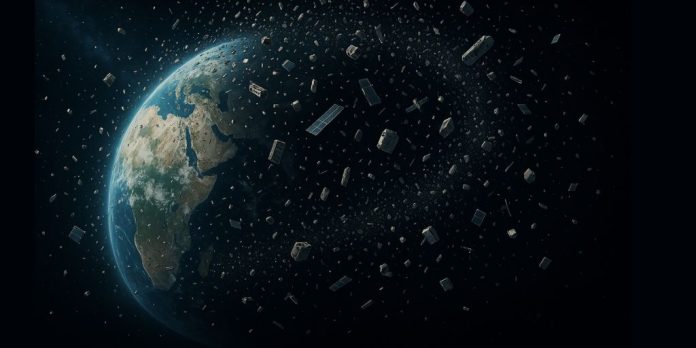Space has long been romanticized as the final frontier: a vast, untapped expanse of infinite possibility. But while we gaze at the stars, something more troubling is happening just above our heads: space debris pollution. This hidden crisis is quickly becoming one of the biggest environmental threats humanity faces, not on Earth, but around it.
In this article, we’ll explore what space debris is, how it threatens our daily lives, the industries most affected, and what’s being done to prevent a potential catastrophe. Whether you’re a space enthusiast, environmental advocate, or just curious about the cosmos, this guide is for you.
What is Space Debris Pollution?
Space debris, also known as orbital debris or space junk, refers to the non-functional, human-made objects orbiting Earth. These include:
- Defunct satellites
- Spent rocket stages
- Fragments from collisions and explosions
- Tools accidentally lost during spacewalks
According to NASA, more than 170 million pieces of debris exist in orbit ranging from flecks of paint to entire satellites traveling at speeds up to 28,000 km/h (17,500 mph). At those speeds, even a tiny object can cause catastrophic damage.
How Did We Get Here? A Brief History of Space Waste
Since the launch of Sputnik 1 in 1957, humanity has sent over 11,000 satellites into orbit. Many of these remain in space even after their missions end. The Cold War arms race, increasing commercial space ventures, and the rise of satellite internet systems (like Starlink) have only worsened the problem.
Key milestones contributing to space debris pollution:
- 2007: China destroyed one of its own satellites during an anti-satellite missile test, creating over 3,000 pieces of trackable debris.
- 2009: A defunct Russian satellite collided with an active U.S. commercial satellite, creating more than 2,000 large debris fragments.
- Today: Mega-constellations like Starlink and OneWeb are deploying thousands of satellites, increasing orbital congestion.
Why Space Debris is a Serious Problem
Space debris pollution isn’t just a technical annoyance, it’s a growing existential threat to modern life and future space exploration.
1. Collision Risks
Satellites are critical to GPS navigation, weather forecasting, global communications, and military operations. Debris traveling at hypersonic speeds can destroy these satellites, causing:
- Loss of internet and communication systems
- Disruption to air traffic control and GPS
- Billions of dollars in damages
2. The Kessler Syndrome
Proposed by NASA scientist Donald Kessler in 1978, this theory warns of a domino effect: one collision leads to more debris, which leads to more collisions, eventually making certain orbits unusable for decades.
3. Threat to Human Life
The International Space Station (ISS) performs regular maneuvers to avoid debris. A single hit could jeopardize the lives of astronauts aboard.
4. Barriers to Future Exploration
As we look to the Moon, Mars, and beyond, the safety of launch paths and orbital routes becomes critical. A crowded low-Earth orbit (LEO) could delay or even derail future missions.
Who’s Responsible for Space Junk?
Space is a shared resource, but unfortunately, no one truly owns it and that’s part of the problem.
Major contributors include:
- Government space agencies (NASA, Roscosmos, CNSA, ESA, ISRO)
- Private companies (SpaceX, Boeing, OneWeb, Blue Origin)
- Military satellites and defense agencies
Lack of enforceable global laws means companies and countries often operate with minimal accountability.
What is Being Done to Combat Space Debris?
Despite the challenges, there is hope. Innovative minds around the world are tackling the issue with technology, policy, and collaboration.
1. Active Debris Removal (ADR)
Technologies in development include:
- Robotic arms and nets to capture junk
- Harpoons and tethers to pull objects back into Earth’s atmosphere
- Laser systems to deorbit small debris
Notable projects:
- ESA’s ClearSpace-1: A Swiss-led mission aiming to remove debris in 2026.
- Astroscale: A Japanese company working on end-of-life satellite servicing and removal.
2. Improved Satellite Design
Newer satellites are being built with:
- Autonomous collision avoidance
- Deorbiting capabilities
- Longer lifespans and fuel-efficient systems
3. Global Policy Initiatives
- UN COPUOS and Outer Space Treaty provide legal frameworks.
- Space Sustainability Rating (SSR): Encourages responsible satellite behavior through a rating system.
Still, enforcement remains a challenge.
How Can We Prevent Future Space Debris Pollution?
Solving this crisis requires proactive, sustainable action:
- Mandatory end-of-life plans for all satellites
- International cooperation and legislation
- Standardized tracking systems to monitor debris
- Public-private partnerships for funding and innovation
Education is also key. Raising awareness among citizens, investors, and governments will push for better solutions and accountability.
Conclusion
Space debris pollution might seem distant, but its impacts are closer than we think. Every time we use GPS, stream a movie, or check the weather, we rely on satellites vulnerable to this hidden threat.
But with innovation, cooperation, and responsible exploration, we can preserve the final frontier not just for us, but for generations to come.
Let’s not repeat Earth’s mistakes in space. The time to act is now.
FAQs About Space Debris Pollution
Q1: Can space debris fall to Earth?
Yes, but most debris burns up in the atmosphere. Only large fragments may survive re-entry, and those typically land in oceans or uninhabited areas.
Q2: How is debris tracked?
Agencies like the U.S. Space Surveillance Network track over 27,000 objects in orbit using radar and telescopes.
Q3: Who pays for cleanup?
Currently, no universal system exists. Some spacefaring nations are investing in cleanup, but long-term responsibility remains unclear.
Q4: Is space debris pollution reversible?
With time, technology, and global cooperation, orbital debris can be managed—but prevention is the most sustainable strategy.

